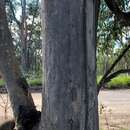en
names in breadcrumbs


Eucalyptus major, commonly known as grey gum,[2] is a species of tree that is endemic to a small area near the New South Wales - Queensland border. It has smooth greyish bark, lance-shaped adult leaves, flower buds in groups of seven and conical to cup-shaped fruit.
Eucalyptus major is a tree that typically grows to a height of 20 m (66 ft) and forms a lignotuber. It has smooth, blotched greyish bark that is shed in large plates or flakes. Young plants and coppice regrowth have egg-shaped leaves that are a lighter shade of green on the lower side, 75–100 mm (3.0–3.9 in) long and 25–40 mm (0.98–1.57 in) wide. Adult leaves are lance-shaped to curved, dark green on the upper surface, paler below, 90–200 mm (3.5–7.9 in) long and 20–40 mm (0.79–1.57 in) wide, tapering to a petiole 15–30 mm (0.59–1.18 in) long. The flower buds are arranged in leaf axils in groups of seven on a flattened, unbranched peduncle 7–15 mm (0.28–0.59 in) long, the individual buds sessile or a pedicels up to 5 mm (0.20 in) long. Mature buds are oval to diamond-shaped, 6–9 mm (0.24–0.35 in) long and 4–5 mm (0.16–0.20 in) wide with a conical operculum. Flowering has been recorded in November and the flowers are white. The fruit is a woody, conical to cup-shaped capsule 3–5 mm (0.12–0.20 in) long and 4–8 mm (0.16–0.31 in) wide with the valves protruding prominently above the rim of the fruit.[2][3][4]
This eucalypt was first formally described in 1923 by Joseph Maiden who gave it the name Eucalyptus propinqua var. major and published the description in his book A Critical Revision of the Genus Eucalyptus.[5][6] In 1934, William Blakely raised the variety to species status as Eucalyptus major, publishing the change in his book A Key to the Eucalypts.[7] The specific epithet (major) is a Latin word meaning "greater".[8]
The grey gum grows in tall forest in coastal areas and nearby hills in south-eastern Queensland, south from the Blackdown Tableland to far northern New South Wales.[2][3][4]
This eucalypt is classified as "least concern" in Queensland under the Queensland Government Nature Conservation Act 1992.[9]
Eucalyptus major, commonly known as grey gum, is a species of tree that is endemic to a small area near the New South Wales - Queensland border. It has smooth greyish bark, lance-shaped adult leaves, flower buds in groups of seven and conical to cup-shaped fruit.
 flower buds
flower buds
Eucalyptus major, communément appelé en anglais : grey gum[2], le gommier gris, est une espèce d'arbre endémique de l'est de l'Australie, précisément d'une petite zone près de la frontière entre la Nouvelle-Galles du Sud et le Queensland. Il a une écorce grisâtre et lisse, des feuilles adultes lancéolées, des boutons floraux par groupes de sept et des fruits coniques à en forme de coupe.
Eucalyptus major atteint généralement une hauteur de 20 m et forme un lignotuber. Son écorce lisse est grisâtre et tachetée ; elle se détache en grandes plaques ou en flocons. Les jeunes plants et la repousse des taillis ont des feuilles ovoïdes d'un vert plus clair sur la face inférieure, longues de 75 à 100 mm et larges de 25 à 40 mm. Les feuilles adultes sont lancéolées à courbes, vert foncé sur la face supérieure, plus pâles en dessous, longues de 90 à 200 mm et larges de 20 à 40 mm, se rétrécissant en un pétiole de 15 à 30 mm.
Les boutons floraux sont disposés à l'aisselle des feuilles en groupes de sept sur un pédoncule aplati et non ramifié de 7 à 15 mm ; les boutons individuels sont sessiles ou portés par un pédicelle pouvant atteindre 5 mm de long. Les boutons matures sont ovales ou en forme de losange, longs de 6 à 9 mm et larges de 4 à 5 mm, avec un opercule conique. La floraison a été constatée en novembre. Les fleurs sont blanches. Le fruit est une capsule ligneuse, conique ou en forme de coupe, longs de 3 à 5 mm et larges de 4 à 8 mm, avec les valves saillantes au-dessus du bord[2],[3],[4].
Cet eucalyptus a été formellement décrit pour la première fois en 1923 par Joseph Maiden, qui lui a donné le nom d'Eucalyptus propinqua var. major et a publié sa description dans son livre A Critical Revision of the Genus Eucalyptus[5],[6]. En 1934, William Blakely a élevé la variété au statut d'espèce sous le nom Eucalyptus major, publiant le changement dans son livre A Key to the Eucalypts[7]. L'épithète spécifique major est un mot latin signifiant « plus grand »[8].
Le gommier gris pousse dans les grandes forêts des zones côtières et des collines voisines du sud-est du Queensland, au sud du plateau de Blackdown, jusqu'à l'extrême nord de la Nouvelle-Galles du Sud[2],[3],[4].
Cet eucalyptus est classé comme « préoccupation mineure » dans le Queensland selon la loi de 1992 sur la conservation de la nature du gouvernement du Queensland[9].
Eucalyptus major, communément appelé en anglais : grey gum, le gommier gris, est une espèce d'arbre endémique de l'est de l'Australie, précisément d'une petite zone près de la frontière entre la Nouvelle-Galles du Sud et le Queensland. Il a une écorce grisâtre et lisse, des feuilles adultes lancéolées, des boutons floraux par groupes de sept et des fruits coniques à en forme de coupe.
Eucalyptus major là một loài thực vật có hoa trong Họ Đào kim nương. Loài này được (Maiden) Blakely mô tả khoa học đầu tiên năm 1934.[1]
Eucalyptus major là một loài thực vật có hoa trong Họ Đào kim nương. Loài này được (Maiden) Blakely mô tả khoa học đầu tiên năm 1934.